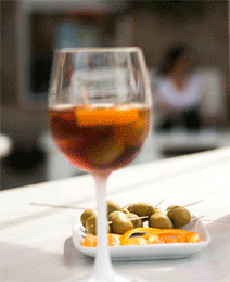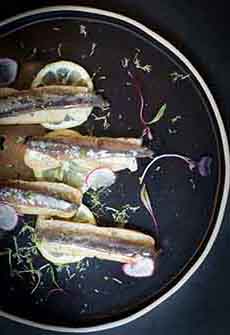TIP OF THE DAY: Vermouth & Tapas, For Brunch & Cocktails
|
Vermouth is enjoying a renaissance. Vermouth (ver-MOOTH) is a fortified wine—one that includes a base spirit—flavored with a proprietary mixture of botanicals (roots, barks, flowers, seeds, herbs, spices).
A glass of sweet red vermouth with an orange slice or twist was long a fashionable apéritíf for café society*. In Barcelona today, vermouth and tapas are a hot duo after mass, both at home and at the vermuterías that have popped up to serve them. Today’s tip is to try a bit of café society at home. Turn it into a brunch or cocktail party with tapas. Use the occasion to get to know vermouth, trying the different styles. You don’t have to try them all in one day. We’ve turned our monthly Sunday friends-and-family brunch into a vermouth and tapas event, trying different vermouths and tapas each week. So it doesn’t get burdensome, participants are assigned to bring a bottle (for those who don’t cook) and a variety of tapas (for those who do). > Check out the tapas below, and have a great time! > National Vermouth Day is March 21st. > World Tapas Day is the third Thursday of June. Vermouth evolved from a 16th-century practice in Northern Italy and Germany, where apothecaries would blend extracts of herbs and roots with wine and brandy. This was the way to make bitter medicines more palatable. (Virtually all spirits were first developed for medicinal reasons.) The original recipe for red vermouth, and possibly even the name “vermuth,” was invented in Torino, Italy in 1786 by Antonio Benedetto Carpano. The red vermouths of subsequent producers like Cinzano were based on Carpano. Carpano is still a major brand in Italy, perhaps best known today in the U.S. for its Punt e Mes (“Point And A Half”), a sweet and bitter style. In the late 19th century, bartenders began to make cocktails with vermouth. The Manhattan and Negroni, made with sweet vermouth, and the Martini, made with dry vermouth, are three that remain popular today. A plain glass of sweet vermouth is still enjoyed as an apéritif in Italy, France, and Spain, the three largest producing countries. |
|
|
|
There are a number of different vermouth styles: sweet and dry, red and white, amaro (with added bitters), chinato with added chinchona (quinine) and often gentian (a root), alla vaniglia with vanilla, and others. Vermouth houses typically make a variety of styles. While many vermouths are regional and not imported, familiar names in the U.S. include: |
||
|
|
VERMOUTH & TAPAS After Ferran Adría closed the famed El Bulli temple of molecular gastronomy, he opened a vermutería in Barcelona: Bodega 1900, that serves different vermouths and tapas. In Barcelona, the trendy food capital of Europe, vermouth is now the midday fashion on weekends. It’s called “la hora del vermout” (vermouth hour, after “cocktail hour”): good food and drink, good conversation, a good time hanging out with friends and family. It’s easy to create your own “la hora del vermout” for brunch or an all-vermouth-and-tapas cocktail party. Here’s what the menu at a tapas bar looks like. We promise, you’ll love this new approach to brunch and/or cocktails. |
|
|
SPANISH ANCHOVIES Many Americans recoil at the thought of anchovies, tough, bristly and way too salty. But these are cheap anchovies, typically served by diners and pizzerias. You must try fine Spanish anchovies—practically another species. Tender Spanish anchovies and boquerones, white anchovies, are imported canned and available fresh in May and June. They are a classic Spanish tapa. Boquerones are lightly pickled in vinegar and olive oil. Lightly salted and smoked anchovies are only distantly related to the over-salted anchovies too many of us have had. They are truly delicious, typically served with bread and butter. Try them: La Tienda is an importer of fine Spanish foods, and the photos of anchovies on their website will change your mind, even before the first bite. *Café society was the precursor of the jet set, and what more recently has been called the “beautiful people.” Beginning in the late 19th century, these wealthy individuals and celebrities gathered in fashionable cafés and restaurants in New York, Paris, and London. As a social group, they attended each others’ private dinners and balls, vacationed at the same elegant resorts, and so forth. In New York City, café society would hang out at El Morocco, the 21 Club and the Stork Club. American journalist Lucius Beebe (1902-1966) is generally credited with creating the term “café society” in his weekly column in the New York Herald Tribune, which ran in the 1920s and 1930s. |
||



